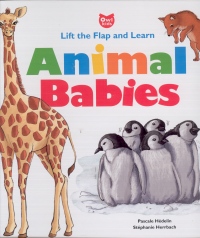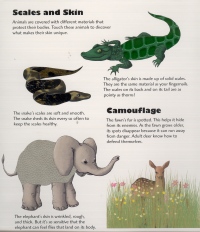| ________________
CM . . .
. Volume XVIII Number 1. . . .September 2, 2011 
 |
Animal Babies. (Lift the Flap and Learn).
Pascale Hédelin. Illustrated by Stéphanie Herrbach. Translated by Marilena Stalteri.
Toronto, ON: Owlkids, 2010.
38 pp., hardcover, $27.95.
ISBN 978-1-897349-90-8.
Subject Headings:
Animals-Infancy-Juvenile literature.
Lift-the-flap books-Specimens.
Preschool-grade 3 / Ages 4-8.
Review by Dave Jenkinson.
*** /4
|
| |
|

excerpt:
Baby Steps
Dolphins mate to make babies. The male drops reproductive cells, called sperm, into the female's body. One of the sperm joins with a cell from the female, called an egg, and a baby begins to grow. This happens with many animals - and people, too!
Originally published in France as Le grand livre animé des bébés animaux, Animal Babies is not a book about the young of various species of animals. Instead, Animal Babies provides an overview of the development of a number of different creatures that walk, fly or swim, from their conception to the end of their life span. Eighteen pairs of facing pages function as "chapters" with each pairing focussing on a different topic or theme.
 After the first three pairings which deal with the period from conception through the creatures' births, the next two sets of pages focus on the immediate needs of the newly born, including food. "Animal Talk" describes various ways in which animals communicate with each other via using sounds or body language. Body coverings make up a portion of "Amazing Animals" while "Squeaky Clean!" examines some of the ways animals carry out their "ablutions." "The Five Senses" reveals how many animals' senses differ from humans' senses. Forms of locomotion are the stuff of "On the Move," and "Baby Beware" reveals how four different animals defend themselves from predators. "Just Like Adults" shows how young animals learn by imitating the actions of the adult animals around them, and "Growing Up" reveals some of the physical changes that occur in animals as they mature. "Moving Out" completes the cycle as the creatures now become capable of reproducing themselves. A vine of life spans, involving 11 critters, completes Animal Babies, with flies being shown to have the shortest life span (2 to 5 months) and elephants to have the longest life span (60 to 100 years) amongst this selected group. After the first three pairings which deal with the period from conception through the creatures' births, the next two sets of pages focus on the immediate needs of the newly born, including food. "Animal Talk" describes various ways in which animals communicate with each other via using sounds or body language. Body coverings make up a portion of "Amazing Animals" while "Squeaky Clean!" examines some of the ways animals carry out their "ablutions." "The Five Senses" reveals how many animals' senses differ from humans' senses. Forms of locomotion are the stuff of "On the Move," and "Baby Beware" reveals how four different animals defend themselves from predators. "Just Like Adults" shows how young animals learn by imitating the actions of the adult animals around them, and "Growing Up" reveals some of the physical changes that occur in animals as they mature. "Moving Out" completes the cycle as the creatures now become capable of reproducing themselves. A vine of life spans, involving 11 critters, completes Animal Babies, with flies being shown to have the shortest life span (2 to 5 months) and elephants to have the longest life span (60 to 100 years) amongst this selected group.
Pascale Hédelin's text is presented in brief, captioned blocks. The book's content is not meant to be exhaustive, but instead it is intended to whet readers' curiosity. However, there are some instances when readers might like more detail, such as when Hédelin says, "Some animals reproduce without mating at all!" Given the exclamation mark, it would be desirable that some examples be provided. Overall, the text is well-supported by Herrbach's artwork.
Virtually every pair of facing pages has something that calls upon the reader to lift a flap, pull a tab, shake the page or touch or push something, actions which, when completed, then yield additional visual or textual information. For example, readers are informed that "The giraffe is very tall and gives birth standing up." Readers are instructed, "Pull the tab to give birth to her calf!"
Although the book's pages are sturdily bound by wire spiral bounding and are contained within a thick board cover, the book's Achilles' heel is, of course, the various tabs, flaps, etc., that young fingers must manipulate in order to access the book's full content. While a fine home purchase, Animal Babies could be a problematic institutional purchase because of its manipulable components.
Recommended.
Dave Jenkinson, CM's editor, lives in Winnipeg, MB.

To comment
on this title or this review, send mail to cm@umanitoba.ca.
Copyright © the Manitoba Library Association. Reproduction for personal
use is permitted only if this copyright notice is maintained. Any
other reproduction is prohibited without permission.
NEXT REVIEW |
TABLE OF CONTENTS FOR THIS ISSUE
- September 2, 2011May 20, 2011.
AUTHORS |
TITLES |
MEDIA REVIEWS |
PROFILES |
BACK ISSUES |
SEARCH |
CMARCHIVE |
HOME |

 After the first three pairings which deal with the period from conception through the creatures' births, the next two sets of pages focus on the immediate needs of the newly born, including food. "Animal Talk" describes various ways in which animals communicate with each other via using sounds or body language. Body coverings make up a portion of "Amazing Animals" while "Squeaky Clean!" examines some of the ways animals carry out their "ablutions." "The Five Senses" reveals how many animals' senses differ from humans' senses. Forms of locomotion are the stuff of "On the Move," and "Baby Beware" reveals how four different animals defend themselves from predators. "Just Like Adults" shows how young animals learn by imitating the actions of the adult animals around them, and "Growing Up" reveals some of the physical changes that occur in animals as they mature. "Moving Out" completes the cycle as the creatures now become capable of reproducing themselves. A vine of life spans, involving 11 critters, completes Animal Babies, with flies being shown to have the shortest life span (2 to 5 months) and elephants to have the longest life span (60 to 100 years) amongst this selected group.
After the first three pairings which deal with the period from conception through the creatures' births, the next two sets of pages focus on the immediate needs of the newly born, including food. "Animal Talk" describes various ways in which animals communicate with each other via using sounds or body language. Body coverings make up a portion of "Amazing Animals" while "Squeaky Clean!" examines some of the ways animals carry out their "ablutions." "The Five Senses" reveals how many animals' senses differ from humans' senses. Forms of locomotion are the stuff of "On the Move," and "Baby Beware" reveals how four different animals defend themselves from predators. "Just Like Adults" shows how young animals learn by imitating the actions of the adult animals around them, and "Growing Up" reveals some of the physical changes that occur in animals as they mature. "Moving Out" completes the cycle as the creatures now become capable of reproducing themselves. A vine of life spans, involving 11 critters, completes Animal Babies, with flies being shown to have the shortest life span (2 to 5 months) and elephants to have the longest life span (60 to 100 years) amongst this selected group.